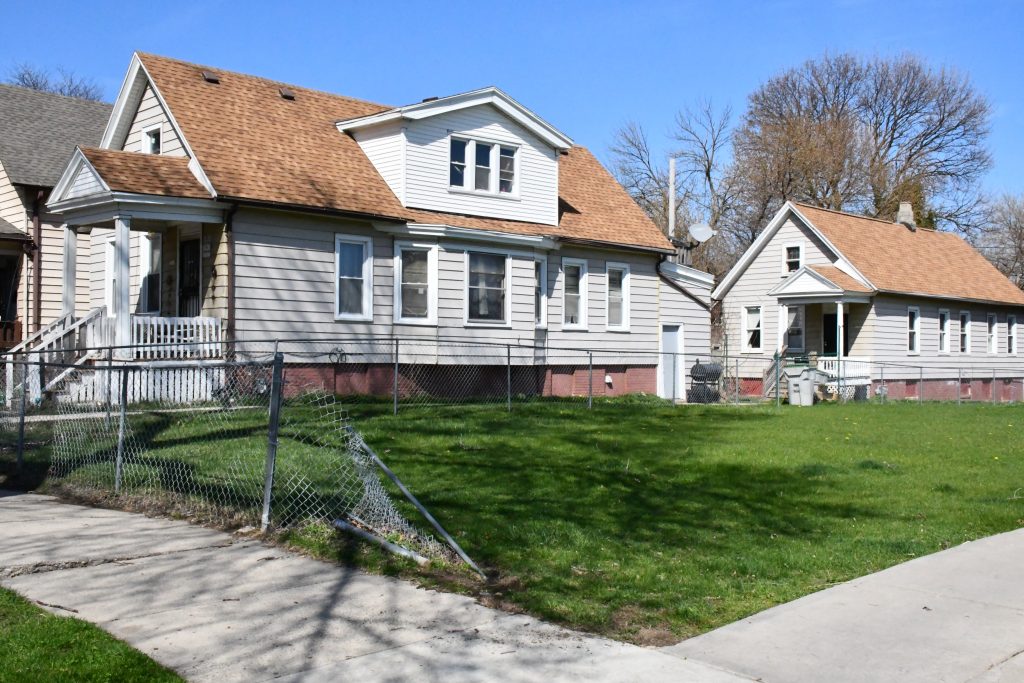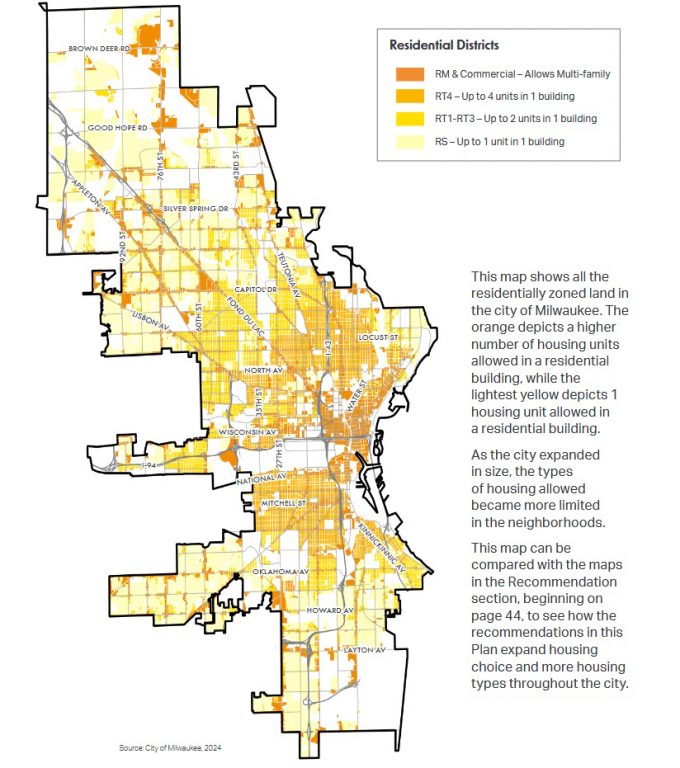After Lengthy Debate, Council Legalizes Carriage Homes
Did Milwaukee just eliminate single-family zoning?

3234 N. 2nd St. House and Carriage HousePhoto taken April 23, 2025 by Jeramey Jannene. All Rights Reserved.
By a single vote the Milwaukee Common Council approved the return of a housing style commonly built more than 100 years ago: the carriage home.
Formally known as an accessory dwelling unit (ADU), the housing style is viewed as a “gentle density” increase and one of several strategies to address a national housing crisis. Co-sponsor Alderperson JoCasta Zamarripa said ADUs provide a way for people to affordably age in place and provide a desirable structure for multi-generational housing.
But one alderman charges the city eliminated single-family zoning by approving the policy.
The proposal includes requirements on siting, size and that the applicant must be an owner-occupant at the time a permit is pulled. Part of a nationwide trend to re-legalize the housing type, co-sponsor Common Council President José G. Pérez previously called his proposal one of the “most restrictive” ADU legalizations. Cities ranging from Seattle to Wauwatosa have already approved allowing new ADUs.
But despite the restrictions, Ald. Scott Spiker isn’t pleased.
Across more than an hour of debate Tuesday morning, he tried to get his colleagues to adopt even more restrictions. He first attempted to get any internal ADU in a single-family area to require approval from the quasi-judicial Board of Zoning Appeals (BOZA), then, after his first proposal failed, expanded it to require all ADUs in single-family areas to require BOZA approval.
“Without any notification of our residents, my fear is this they’ll wake up and they’ll call me and say ‘why did you allow this?’ And I’ll say ‘Allow it? I didn’t even know about it.'”
Requiring BOZA approval would require those seeking an ADU to pay a fee of several hundred dollars and get architectural drawings produced with the risk that their proposal could be rejected.
“Alderman Spiker’s [amendment] makes internal ADUs pretty much an impossibility,” said Zamarripa, raising concerns about the at-risk costs.
“Neighbors have a right to know about this and have a say. That doesn’t mean their say carries the day,” said Spiker. He said without BOZA approval what is effectively a new duplex could be built in a row of single-family homes with without notice. It could quickly become a short-term rental on platforms like Airbnb.
“This is simply a moment of fear mongering from my colleague,” said Ald. Mark Chambers, Jr. “I could go on and on, but I’m not going to be like him.”
“We are in a crisis,” said Alderwoman Marina Dimitrijevic, referencing spiking housing costs and other economic challenges. “We can’t use old broken tools to fix this terrible problem. Will accessory dwelling units solve it all? Of course not, but they’re a step in the right direction.”
She also chided Spiker for raising fear about duplexes. “To suggest that duplexes are hard to manage or could jolt the entire neighborhood. I’m kind of surprised by that,” she said. Duplexes, said Dimtriejvic, provide an economic mobility pathway.
Ald. Alex Brower echoed her comments and noted he grew up for a time in a duplex. The issue has become a hot-button topic in his district and a possible exemption for a portion of the East Side initially held up the proposal’s adoption in April.
“We need to take a systemic approach to this problem and offer as many options as possible for people here in the city to provide more housing, even at the rental level,” said the newly-elected alderman. True to form, he also said if Spiker and others have concerns about investors buying up properties, they can explore socialism as a solution. “Welcome to my world view.”
“I don’t know that we have to go to the evils of capitalism to really resolve this difference,” said Ald. Robert Bauman, a lead co-sponsor with Pérez.
“I am lost in what’s happened,” said Ald. Andrea Pratt. She said neighbors deserve notice. “If you are someone that can afford to build another building on your lot, you can probably afford a $600 special use permit.” She said Spiker’s proposal added transparency.
“This is not going to solve the housing crisis,” said Ald. Peter Burgelis of Spiker’s proposal. Burgelis, a prominent backer of the ADU proposal, said he had to seek out a rare side-by-side duplex in his district to find somewhere to live with his elderly mother. Under the ADU proposal, he could have purchased any residential property and modified it, provided the proposal met the design guidelines.
The ADU supporters said Spiker’s proposal was restrictive. Bauman previously said that if too many ADUs were built, the council could revisit its regulations.
“We are just saying – inform the community,” said Ald. Russell W. Stamper, II. “The word ‘restrictive’ is inaccurate, because you can do it, you just have to go get permission and inform the community about it.”
But Bauman said residents currently have the ability to petition BOZA for an ADU and it’s “virtually impossible.” The city currently doesn’t define an ADU in its zoning code, requiring a more complicated variance. Applicants must have plans prepared for a BOZA review, which can be costly, and risk rejection.
A series of procedural votes all failed by the same, one-vote 8-7 margin against. The ADU proposal was adopted by the same 8-7 affirmative vote by Chambers, Brower, Bauman, Zamarripa, Burgelis, Dimitrijevic, Perez and Sharlen P. Moore. Pratt, Spiker, Stamper, Lamont Westmoreland, Milele A. Coggs, DiAndre Jackson and Larresa Taylor voted in opposition.
The city’s RS1 through RS6 designations, used for single-family housing, primarily apply to the city’s newer homes, mostly located north of Capitol Drive and west of 60th Street on the northwest side, south of Oklahoma Avenue on the southeast side and southwest of Jackson Park on the southwest side. It also includes the area around UW-Milwaukee.
Legislation Link - Urban Milwaukee members see direct links to legislation mentioned in this article. Join today
If you think stories like this are important, become a member of Urban Milwaukee and help support real, independent journalism. Plus you get some cool added benefits.
More about the Growing MKE proposal
- Milwaukee Seeks ‘Missing Middle’ Housing Developers - Jeramey Jannene - Nov 24th, 2025
- Milwaukee Aims To Build ‘Missing Middle’ Housing in 2026 - Jeramey Jannene - Oct 29th, 2025
- Despite Its Passage, ‘Growing MKE’ Still Not A Done Deal - Jeramey Jannene - Sep 16th, 2025
- Mayor Signs Housing Legislation, Praises Late Jonathan Brostoff - Jeramey Jannene - Jul 16th, 2025
- Council Adopts Growing MKE Plan - Jeramey Jannene - Jul 15th, 2025
- After Lengthy Debate, Council Legalizes Carriage Homes - Jeramey Jannene - Jul 15th, 2025
- Housing Plan Wins Key Council Committee Endorsement - Jeramey Jannene - Jul 9th, 2025
- City Hall: Committee Waters Down Proposed ‘Granny Flat’ Plan - Jeramey Jannene - Jun 17th, 2025
- Madison Pursuing Its Own Zoning Reform Similar To ‘Growing MKE’ - Sarah Lehr - Jun 12th, 2025
- ‘Growing MKE’ Proposal Picks Up Key Endorsement - Jeramey Jannene - Jun 2nd, 2025
Read more about Growing MKE proposal here
Political Contributions Tracker
Displaying political contributions between people mentioned in this story. Learn more.
- October 23, 2024 - DiAndre Jackson received $75 from Sharlen P. Moore
- April 23, 2019 - JoCasta Zamarripa received $100 from Peter Burgelis
- February 13, 2016 - Milele A. Coggs received $10 from Larresa Taylor
- May 5, 2015 - José G. Pérez received $100 from JoCasta Zamarripa





















What a stunning turn! It shouldn’t be this hard to get common sense stuff through but here we are..
Jeez what is Spiker’s deal??!!